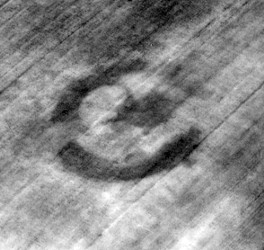Introduction
Around 3100 BC, there was a huge change in the way people did things. No new long barrows, cursuses or causewayed enclosures were built and those that existed fell into disuse. Instead, burials were made under round barrows, new types of ceremonial sites were built (which we call henges) and, after about six hundred years, metal tools were imported from Ireland. By about 2200 BC, bronze was made from copper and tin mined in Britain.
These early bronze objects were rare and valuable, so most tools were still made of flint. The earliest bronze objects in Britain were simple-shaped axes and daggers, and these are normally found in graves. Most metalwork consisted of weapons rather than tools and it has been said that the Bronze Age saw the first ‘arms race’.
Flint and other stones were still used for some tools and weapons. Heavy stone ‘battle axes’ and axe hammers were made, as well as fine, sharp flint arrowheads.
Towards the end of this period, a new type of building was developed, the roundhouse. New types of pottery were also made. The older styles, which were simple, black bowls, gave way to highly decorated red or orange bowls and, after 2500 BC, tall yellowish beakers. The beaker style is found all over Western Europe and north-west Africa and shows the development of long-distance trade as metalworkers needed sources of copper and, especially, tin, to make bronze.
Local evidence
Excavations in the 1960s at Blackhorse Road in Letchworth Garden City uncovered a site dating from this period. Large numbers of boundary ditches and pits were excavated over many years, some of which contained flint tools and pottery made in the Beaker Period, around 2,500 to 2,000 BC, as well as the bones of sheep and cattle. These pits may have been dug to get at flint nodules, which were used for making tools. They were later filled up with débris.
At Codicote Heath, pottery sherds and flint tools were found in shallow hollows and a roundhouse that had been protected beneath a later burial mound. At Baldock, flint tools and pottery similar to that from Blackhorse Road were found in excavations of the Iron Age and Roman town. One pit was used as a rubbish pit by an early flintworker and on anther site, the chips of flint left by someone making tools were simply left scattered on the ground. A building stood nearby, in a hollow close to Royston Road.
 In this aerial photograph, the dark semi-circular marks show the position of a filled-in ditch. The gaps would have been entrances, while the soil and chalk taken from the ditch would have been piled up inside to make a bank. Henges were probably used for religious rituals; sometimes the ditches contain the remains of animals eaten at feasts and sometimes human burials are found inside them.
In this aerial photograph, the dark semi-circular marks show the position of a filled-in ditch. The gaps would have been entrances, while the soil and chalk taken from the ditch would have been piled up inside to make a bank. Henges were probably used for religious rituals; sometimes the ditches contain the remains of animals eaten at feasts and sometimes human burials are found inside them.
Around 3100 BC, people stopped using long barrows. In those parts of Britain where they covered stone-built chambers, the chambers were sealed up. Instead, a new type of burial mound is found: the bowl barrow, so called because the soil is piled up into a circular shape that looks like an upside-down bowl. There is a large bowl barrow beside the railway between Hitchin and Letchworth Garden City.